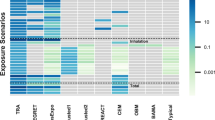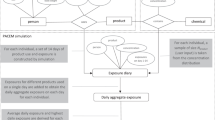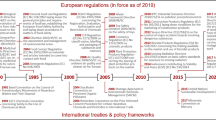Abstract
Understanding where and how chemicals are used throughout their life cycle is becoming increasingly important. In 2003, within the context of REACH and GPSD legislation, the European Commission started developing a European and global infrastructure of exposure methods and tools. The infrastructure aims (1) to link modeling tools and exposure-related data and scenarios in a single framework so that harmonized exposure assessment procedures can be developed for consumer products in the EU and (2) to make this framework flexible enough to allow global application. A number of issues are raised by a global infrastructure of consumer exposure modeling that answers to multi-legislative mandates. These include transparency, consistency, usability, and defensibility of the models, including the relevant degree of complexity for priority setting versus assessment. As part of the initiative to set up a harmonized global infrastructure on consumer exposure assessment, these issues were presented, discussed, and further developed in a series of European Commission-sponsored workshops organized in October 2004 and June 2005 as part of the “Harmonization of Consumer Exposure Models on a Global Scale” project. The project focused on development, harmonization, and validation of consumer exposure modeling approaches. The workshops included experts from the EU, USA, Japan, and Canada. The conclusions and recommendations made on the basis of this work are described. To help achieve harmonization of approaches, the European Commission's Joint Research Centre is proposing a framework (1) to compare information on elements of chemical risk assessment to understand exposure regulations in different countries, (2) to save time and expense by sharing information and models, and (3) to promote credible science through better communication among organizations and by peer review of assessments and assessment procedures.
This is a preview of subscription content, access via your institution
Access options
Subscribe to this journal
Receive 6 print issues and online access
$259.00 per year
only $43.17 per issue
Buy this article
- Purchase on Springer Link
- Instant access to full article PDF
Prices may be subject to local taxes which are calculated during checkout
Similar content being viewed by others
References
Bruinen de Bruin Y., Koistinen K., Yli-Tuomi T., Kephalopoulos S., and Jantunen M. A Review of Source Apportionment Techniques and Marker Substances Available for Identification of Personal Exposure, Indoor and Outdoor Sources of Chemicals. Office for Official Publication of the European Communities, Luxembourg. EUR 22349 EN, 2006.
Council of the European Union, REACH Regulation (EC) No. 1907/2006 of the European Parliament and of the Council, 18 December 2006. 2006.
Global Consumer Exposure Models Net database (http://cem.jrc.it/cemdb/qstart.php), Commission of the European Communities, Joint Research Centre, Institute for Health and Consumer Protection, Physical & Chemical Exposure Unit, 2004.
Global CEM Net. Global Net on “Consumer Exposure Modeling”. In: Kephalopoulos S., van Hemmen J., and van der Jagt K. (Eds.). Workshop no. 1 report on “Dermal Transfer and Penetration algorithms”, 20–21 June 2005, Intra (Italy), Office for Official Publication of the European Communities, Luxembourg. EUR 22521 EN/1, 2006a.
Global CEM Net. Global Net on “Consumer Exposure Modeling”. In: Kephalopoulos S., Arvanitis A., and Jayjock M. (Eds.). Workshop no. 2 report on “Source characterization, transport and fate”, 20–21 June 2005, Intra (Italy), Office for Official Publication of the European Communities, Luxembourg. EUR 22521 EN/2, 2006b.
Global CEM Net. Global Net on “Consumer Exposure Modeling”. In: Kephalopoulos S., Arvanitis A., and Jantunen M. (Eds.). Workshop no. 3 report on “Exposure Modelling Framework Issues”, 22 June 2005, Intra (Italy), Office for Official Publication of the European Communities, Luxembourg. EUR 22521 EN/3, 2006c.
Global CEM Net. Global Net on “Consumer Exposure Modeling”. In: Kephalopoulos, Money C., Price P., and van Engelen J. (Eds.). Workshop no. 4 report on “Exposure related data”, 23 June 2005, Intra (Italy), Office for Official Publication of the European Communities, Luxembourg. EUR 22521 EN/4, 2006d.
Global CEM Net. Global Net on “Consumer Exposure Modeling”. In: Kephalopoulos S., Arvanitis A., and van Engelen J. (Eds.) Workshop no. 5 report on “Exposure scenarios”, 24 June 2005, Intra (Italy), Office for Official Publication of the European Communities, Luxembourg. EUR 22521 EN/5, 2006e.
Netzeva T.I., Worth A.P., Aldenberg T., Benigni R., Cronin M.T.D., Gramatica P., Jaworska J.S., Klopman G., Marchant C.A., Myatt G., Nikolova-Jeliazkova N., Patlewicz G.Y., Perkins R., Roberts D.W., Schultz T.W., Stanton D.T., van de Sandt J.J.M., Tong W., Veith G., and Yang C. Current status of methods for defining the applicability domain of (quantitative) structure-activity relationships. The report and recommendations of ECVAM Workshop 52. Altern Lab Anim 2005: 33: 152–173.
Potts R.O., and Guy R.H. Predicting skin permeability. Pharm Res 1992: 9: 663–669.
US EPA. Human Health Research Strategy, Washington, DC, US EPA, Office of Research and Development (EPA/600/R-02/050), 2003.
van de Sandt J.M., Dellarco M., and van Hemmen J. From dermal exposure to internal dose. J Expo Sci Environ Epidemiol 2007, Advance online publication 18 April 2007; doi: 10.1038/sj.jes.7500759.
Vuori V., Zaleski R.T., and Jantunen M.J. ExpoFacts — an overview of European Exposure Factors Data. Risk Anal 2006: 26 (3): 831–843.
WHO International Programme on Chemical Safety. IPCS risk assessment terminology. 2 pts. in 1 v. — (IPCS harmonization project; document no. 1) Contents: Pt. 1, IPCS/OECD key generic terms used in chemical hazard/risk assessment/International Programme on Chemical Safety Joint Project with OECD on the harmonization of hazard/risk assessment terminology — Pt. 2, IPCS glossary of key exposure assessment terminology/IPCS project on the harmonization of approaches to the assessment of risk from exposure to chemicals, WHO, Geneva, 2004, 122 pp.
WHO International Programme on Chemical Safety. Principles of characterizing and applying human exposure models. (IPCS harmonization project document; no. 3), WHO, Geneva 2005, 76 pp.
WHO International Programme on Chemical Safety. Guidance document on “Characterizing and Communicating Uncertainty in Exposure Assessment”, http://www.who.int/ipcs/methods/harmonization/areas/exposure/en/index.html, 2006.
Acknowledgements
We thank the DG JRC for financially supporting the Global CEM Net project activities. We also thank the 60 experts who contributed to the successful setup and implementation of this activity on a global scale.
Author information
Authors and Affiliations
Corresponding author
Rights and permissions
About this article
Cite this article
Kephalopoulos, S., De Bruin, Y., Arvanitis, A. et al. Issues in consumer exposure modeling: Towards harmonization on a global scale. J Expo Sci Environ Epidemiol 17 (Suppl 1), S90–S100 (2007). https://doi.org/10.1038/sj.jes.7500605
Received:
Accepted:
Published:
Issue Date:
DOI: https://doi.org/10.1038/sj.jes.7500605
Keywords
This article is cited by
-
Enhancing the use of exposure science across EU chemical policies as part of the European Exposure Science Strategy 2020–2030
Journal of Exposure Science & Environmental Epidemiology (2022)
-
Perspectives on advancing consumer product exposure models
Journal of Exposure Science & Environmental Epidemiology (2020)
-
European solvent industry group generic exposure scenario risk and exposure tool
Journal of Exposure Science & Environmental Epidemiology (2014)
-
Characterisation of urban inhalation exposures to benzene, formaldehyde and acetaldehyde in the European Union
Environmental Science and Pollution Research (2008)



